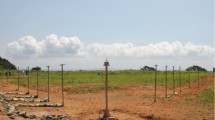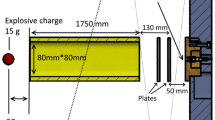Abstract
The aim of this paper is to present an improved method to calculate the pressure loading on walls during a confined explosion. When an explosion occurs inside of an enclosure, reflected shock waves produce multiple pressure peaks at a given wall location, especially at the corners. The effects of confined blast loading may bring about more serious damage to the structure due to multiple shock reflection. An approach, first proposed by Chan to describe the track of shock waves based on the mirror reflecting theory, using the method of images (MOI) is proposed to simplify internal explosion loading calculations. An improved method of images is proposed that takes into account wall openings and oblique reflections that cannot be considered with the standard MOI. The approach, validated using experimental data, provides a simplified and quick approach for loading calculation of a confined explosion. The results show that the peak overpressure tends to decline as the measurement point moves away from the center, and increases sharply as it approaches the enclosure corners. The specific impulse increases from the center to the corners. The improved method is capable of predicting pressure–time history and impulse with an accuracy comparable to that of three-dimensional AUTODYN code predictions.















Similar content being viewed by others
References
Hou, H., Zhu, X., Li, W., Mei, Z.: Experimental studies on characteristics of blast loading when exploded inside ship cabin. J. Ship Mech. 14(8), 901–907 (2010) (in Chinese)
Gao, K., Jin, F., Wang, D., Ma, S.: Review on internal explosion loading building. Chin. Eng. Sci. 15(5), 9–64 (2013) (in Chinese)
Zhang, X., Zhang, Q., Shi, P., Zhou, X.: Investigation on the equivalent loading of constructions under internal explosion. Trans. Beijing Inst. Technol. 33(2), 133–138 (2013) (in Chinese)
Klaseboer, E., Hung, K.C., Wang, C., Khoo, B.C., Boyce, P., Debono, S., Charlier, H.: Experimental and numerical investigation of the dynamics of an underwater explosion bubble near a resilient/rigid structure. J. Fluid Mech. 537(6), 387–413 (2005)
Zhang, A., Yang, W., Huang, C., Ming, F.: Numerical simulation of column charge underwater explosion based on SPH and BEM combination. Comput. Fluids 71, 169–178 (2013)
Zhang, A., Wang, S., Huang, C., Wang, B.: Influences of initial and boundary conditions on underwater explosion bubble dynamics. Eur. J. Mech. B/Fluids 42, 69–91 (2013)
Zhang, A., Zhou, W., Wang, S., Feng, L.: Dynamic response of the non-contact underwater explosions on naval equipment. Mar. Struct. 24(4), 396–411 (2011)
Baker, W.E., Cox, P.A., Kulesz, J.J., Strehlow, R.A., Westine, P.S.: Explosion Hazards and Evaluation. Elsevier, New York (2012)
Zyskowski, A., Sochet, I., Mavrot, G., Bailly, P., Renard, J.: Study of the explosion process in a small scale experiment-structural loading. J. Loss Prev. Process Ind. 17(4), 291–299 (2004)
Wu, C., Lukaszewicz, M., Schebella, K., Antanovskii, L.: Experimental and numerical investigation of confined explosion in a blast chamber. J. Loss Prev. Process Ind. 26(4), 737–750 (2013)
Edri, I., Savir, Z., Feldgun, V.R., Karinski, Y.S., Yankelevsky, D.Z.: On blast pressure analysis due to a partially confined explosion: I. Experimental studies. Int. J. Protect. Struct. 2(1), 1–20 (2011)
Feldgun, V.R., Karinski, Y.S., Edri, I., Tsemakh, D., Yankelevsky, D.Z.: On blast pressure analysis due to a partially confined explosion: II. Numerical studies. Int. J. Protect. Struct. 3(1), 61–79 (2012)
Edri, I., Feldgun, V.R., Karinski, Y.S., Yankelevsky, D.Z.: On blast pressure analysis due to a partially confined explosion: III. Afterburning effect. Int. J. Protect. Struct. 3(3), 311–332 (2012)
UFC3-340-02 (Unified Facilities Criteria): Structures to Resist the Effects of Accidental Explosions. Department of the Army, the NAVY and the Air Force, Washington (2008)
Chan, P.C., Klein, H.H.: A study of blast effects inside an enclosure. J. Fluids Eng. 116(3), 181–189 (1994)
Kong, X.: Research on the Blast Loadings and the Response of Multi-layer Protective Structure. Wuhan University of Technology, Wuhan (2013) (in Chinese)
Zhang, D., Wu, K., Lu, F.: Investigation on dynamic pressure loading exploded inside buildings. Min. Technol. 9(5), 68–72 (2009)
Pedersen, H.H., Tomlin, G., Middha, P., Phylaktou, H.N., Andrews, G.E.: Modelling large-scale vented gas explosions in a twin-compartment enclosure. J. Loss Prevent. Process Ind. 26(6), 1604–1615 (2013)
Langdon, G.S., Ozinsky, A., Yuen, S.C.K.: The response of partially confined right circular stainless steel cylinders to internal air-blast loading. Int. J. Impact Eng. 73(2), 1–14 (2014)
Baker, W.E.: Explosion in Air. University of Texas Press, Austin (1973)
Ning, J., Wang, C., Ma, T.: Explosion and Shock Dynamics. National Defense Industry Press, Beijing (2010)
Li, Y., Liu, L., Tang, Z.: Studies on oblique reflection of shock wave in nonlinear elastic media. Explos. Shock Waves 8(1), 7–14 (1988)
Chen, Z.: Overpressure calculation on the reflection of air shock waves with moving rigid wall. Explos. Shock Waves 4, 004 (1985)
Li, Y., Ma, S.: Explosion Mechanics. Science Press, Beijing (1992) (in Chinese)
Yao, Y.: Study on the Shock Waves’ Features of the Structure Internal Pressure Relief Blast. Chongqing University, Chongqing (2011) (in Chinese)
Kong, X.: Research on Response Simulation of War-Ship Broadside Protective Structure Under Inner Explosion. Wuhan University of Technology, Wuhan (2009) (in Chinese)
Author information
Authors and Affiliations
Corresponding author
Additional information
Communicated by M. Brouillette and G. Ciccarelli.
Rights and permissions
About this article
Cite this article
Wu, Z., Guo, J., Yao, X. et al. Analysis of explosion in enclosure based on improved method of images. Shock Waves 27, 237–245 (2017). https://doi.org/10.1007/s00193-016-0655-y
Received:
Revised:
Accepted:
Published:
Issue Date:
DOI: https://doi.org/10.1007/s00193-016-0655-y




